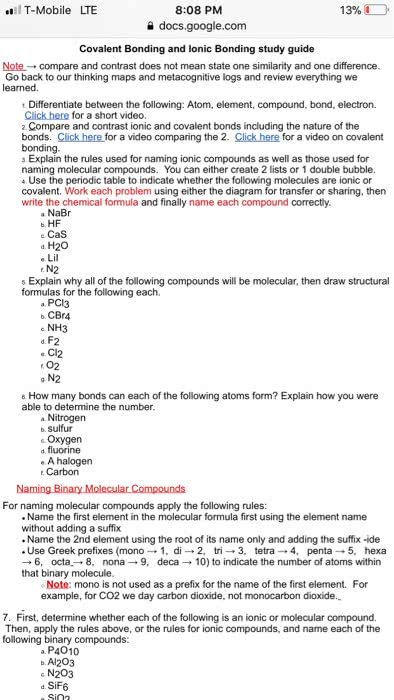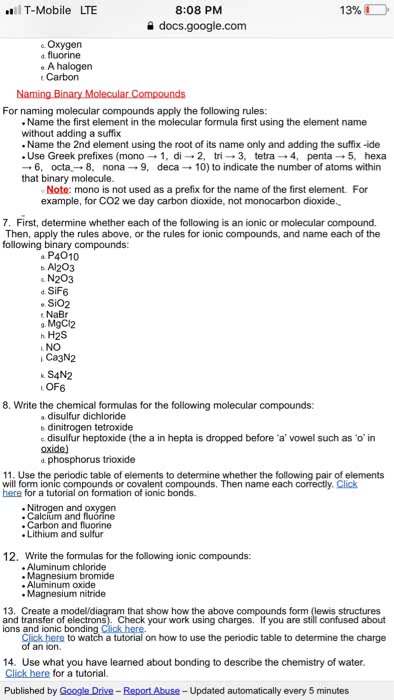CHEM 1500 Lecture Notes - Lecture 17: Binary Phase, Nonmetal, Chemical Formula

L17: BINARY IONIC AND MOLECULAR COMPOUNDS
To write simple formulas of chemical compounds, we need to know:
1) The oxidation states and the rules for oxidation states
2) Whether we have organic compounds or inorganic compounds, because there are different rules for
naming each
Organic Compounds
Compounds of C or H and a few other
nonmetal elements
Organic Chemistry
Inorganic Compounds
All other (than organic) compounds
Inorganic Chemistry
INORGANIC COMPOUNDS
BINARY COMPOUNDS
Binary Compounds: are compounds formed between two elements
- binary compounds are the simplest compounds
- inorganic binary compounds can be made up of either
- two nonmetals (usually molecular compounds)
- a metal and a nonmetal (usually ionic compounds)

BINARY COMPOUNDS OF
METALS & NONMETALS
(BINARY IONIC COMPOUNDS)
- made up of monoatomic ions (b/c its only elements)
- (usually) combine a metal cation (+) and a nonmetal
anion (-)
- the charge of the metal cations is the same as their OS
- the charge of the nonmetal anions is the same as their
OS when combined with metals: OS = - (18-GN)
BINARY COMPOUNDS OF
TWO NONMETALS
(BINARY MOLECULAR COMPOUNDS)
- made up of two nonmetal atoms
- the first nonmetal has a positive OS
- the second nonmetal has a negative OS (usually equal to
-(18-GN))
EXCEPTIONS: 3 binary molecular compounds are
exceptions to the above rules
- ammonia, NH3
- phosphine, PH3
- methane, CH4
In the above:
- the first nonmetal = negative OS (-)
- the second nonmetal (hydrogen) = positive OS (+)
- This is done to emphasize that these are not acids
NAMING BINARY IONIC COMPOUNDS
1) Write the unmodified name of the metal
2) For metals with multiple OS, indicate the OS of the
compound with (roman numeral)
3) Write the name of the nonmetal with the suffix -ide
Note* when naming binary ionic compounds, ignore the
numbers of atoms of each element
NAMING BINARY MOLECULAR COMPOUNDS
1) Write the unmodified name of the first nonmetal (the
one with the positive OS, or the lower EN)
2) Write the name of the second nonmetal (the one with the
negative OS or higher EN), add the suffix -ide
3) For pairs of nonmetals that form more than one binary
molecular compound, indicate the relative number of
atoms through prefixes
1 = mono
2 = di
3 = tri
4 = tetra
5 = penta
6 = hexa
7 = hepta
8 = octa
9 = nona
10 = deca
*mono is not used for the first-named element
CHEMICAL FORMULAS
BINARY IONIC COMPOUNDS
1) Write the symbols for the metal and the nonmetal
2) Assign oxidation states
3) Balance the number of atoms by writing appropriate
subscripts to make the total OS = 0 (because a formula unit
is equal to 0 in charge)
FORMULAS
FOR BINARY MOLECULAR COMPOUNDS
1) Molecular Formula
2) Empirical Formula
3) Structural Formula
4) Condensed Structural Formula
5) Line-Angle Formula
(Lecture 11, textbook 3-1)
Document Summary
To write simple formulas of chemical compounds, we need to know: the oxidation states and the rules for oxidation states, whether we have organic compounds or inorganic compounds, because there are different rules for naming each. Compounds of c or h and a few other. Binary compounds: are compounds formed between two elements. Inorganic binary compounds can be made up of either. A metal and a nonmetal (usually ionic compounds) Two nonmetals (binary ionic compounds) (binary molecular compounds) Made up of monoatomic ions (b/c its only elements) (usually) combine a metal cation (+) and a nonmetal anion (-) The charge of the metal cations is the same as their os. The charge of the nonmetal anions is the same as their. Os when combined with metals: os = - (18-gn) The first nonmetal has a positive os. The second nonmetal has a negative os (usually equal to. Exceptions: 3 binary molecular compounds are exceptions to the above rules.





